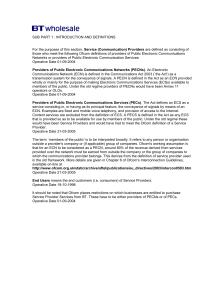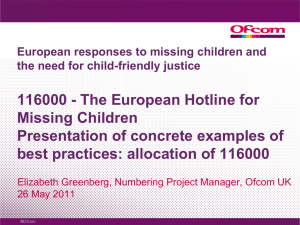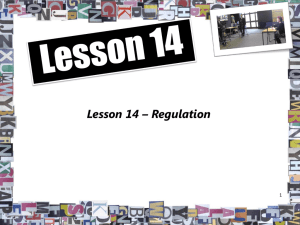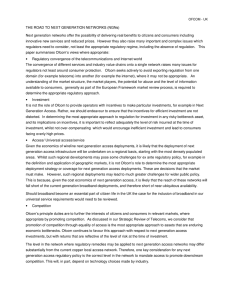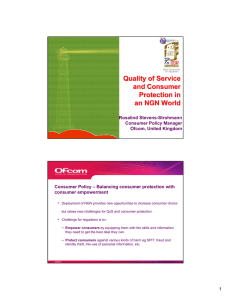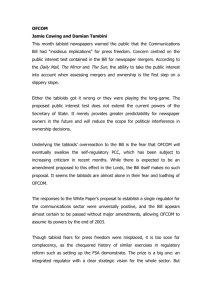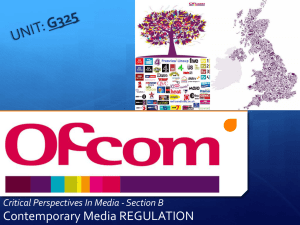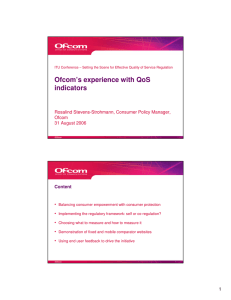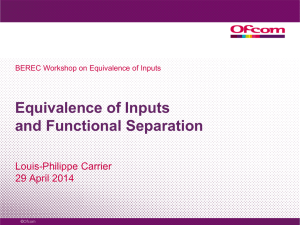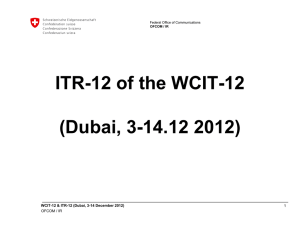Measuring and mitigating media concentration
advertisement
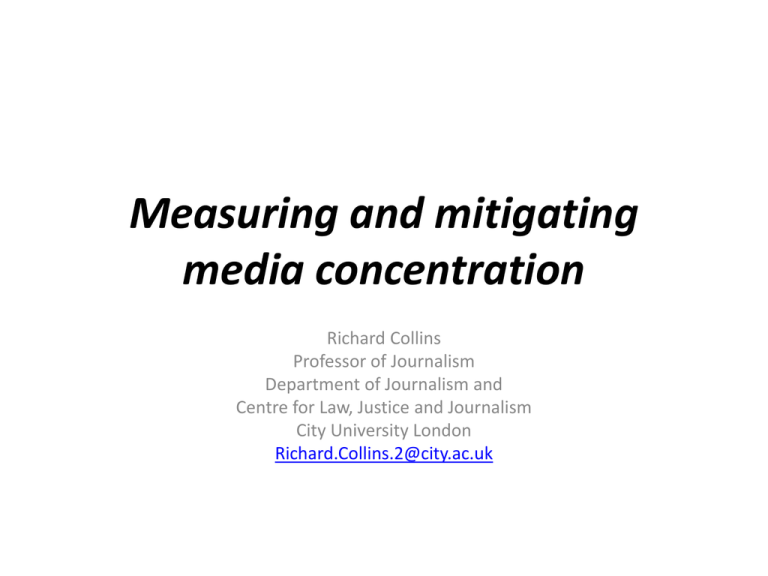
Measuring and mitigating media concentration Richard Collins Professor of Journalism Department of Journalism and Centre for Law, Justice and Journalism City University London Richard.Collins.2@city.ac.uk • Draws on 2013 article in Telecommunications Policy co-authored with Martin Cave - HHI data presented today based on Martin’s work. • Why are we worried? • What’s changing? • Measurement issues. • Remedies? 2 Pervasive concern. • 2013 House of Lords Select Committee enquiry and DCMS enquiry. • UK review by Ofcom 2012. • Australia reviews 2001 (updated in 2002, 2003 and 2006) and 2007. • Canada new media ownership rules 2008. • European Commission Committee on Freedom and Pluralism of the Media 2011 (reported Jan 2013). • Germany, Kommission zur Ermittlung der Konzentration im Medienbereich reviews commercial broadcasting to secure diversity of opinion (Meinungsvielfalt) • USA four yearly reviews of media ownership (latest 2010). 3 Scholarly attention. • Special section of the International Journal of Communication (IJOC 2010). • Czepek et al (2009). • Doyle (2002). • Harcourt (2005). • Hulten et al (2010). • Meier (2005). • Iosifides (2010). • Etc. 4 Why the concern? • Why now? The advertiser-supported model (which sustained print media in particular) is under threat, leading to closures and merger. • Why important? Mass media role in democracies – to influence political behaviour and hold power to account. • Why worry? Regulation less and less effective, government control of entry to media markets declines (broadcasting satellites, the internet etc). 5 • Assumption – concentration diminishes diversity and quality. True? Generally untested empirically - see Milyo for FCC: “local television newscasts for cross-owned stations contain on average about 1-2 minutes more news coverage overall, or 4%-8% more than the average for non-cross-owned stations.………. Newspaper cross-ownership is also associated with more candidate coverage, more candidate speaking time and more coverage of opinion polls………With regard to the partisan slant of news coverage, there is little consistent and significant difference between cross-owned stations and other major network-affiliated stations in the same market” (Milyo 2007: npp). • Economic theory (and some practice) suggests that a rational owner likely to make monopoly product “impartial” and 6 differentiate diverse products. Issues. • Law and regulation focused on “legacy media”. • Legacy media in decline - > closure, merger, concentration. • Partial substitution by “new” media – less subject to regulation, posing problems of exercise of jurisdiction, possible premature regulation etc. • New loci of control: eg subscription management systems, encryption and API protocols, transmission and distribution platforms etc. • New media not (yet) a substitute for legacy media. • Role for “positive” rather than “negative” regulation to respond to market failure. 7 State of play. • Trade balance figures for the newspaper publishing industry in the EU27 show… between 1995 and 2007… an average negative growth rate of 10.6% (Leurdijk et al 2012: 9). • A clear trend towards ownership concentration in the (TV) industry (Sanz 2012: 6). 8 Internet and ads. Ofcom 2010: 214. 9 (Relative) decline of legacy sector. 10 Classic and new sectoral characteristics. • High first copy/low second copy cost structure of the sector - > high returns to economies of scale (and scope) but dramatic loss of profitability once “tipping point” of cost recovery reached. • Intermediaries controlling bottlenecks (Apple, Amazon, Google etc). • “What is new is a significant change in the dynamics of the sector…. Power is shifting towards the downstream, away from the upstream, from the production side of the media toward the distribution side” (Simon 2012: 16). 11 UK rules (CA 2003 & Enterprise Act 2002) • 20/20 rule – no newspaper group with more than 20% share of newspaper consumption can own more than 20% of a Channel 3 (ITV) or becoming the Channel 3 nominated news provider licence. • Prohibition on classes of owners holding broadcasting licences – notably advertisers, political & religious groups and PSBs. • Secretary of State can trigger public interest test re newspapers or broadcasting (only). • Ofcom reviews rules periodically (2009 reduced regulation of local media, radio). 12 Measuring concentration/pluralism. • European Commission’s Media Pluralism Monitor (KUL 2009). • 166 indices, 75 possible threats and 43 distinct risks! • one of the 166 individual indicators, “Political bias in the media”, requires a “Quantitative content analysis for measuring the proportion of actors representing different political viewpoints and groupings by dividing them into 4 groups: government, governing parties, opposition parties, and other political and ideological groupings” (KUL 2009: 46). 13 Equal weight? Defining the market? • MPM attributes “equal weight to all indicators” (KUL 2009: 26): are magazines, radio, television and newspapers equivalent and equal? Book publishing companies, web sites, cable stations etc? (KUL 2009: 78). • What’s the market? Does the Yorkshire Post operate in the same market as The Times? Is BSkyB in the same market as ITV? • Measuring the right things – “retail” media or “wholesale” media (news agencies etc). PSB, in or out? • Revenues (Enders) or consumption? 14 Hirschman-Herfindahl index or HHI. • Customarily used in competition policy/law and by the FCC. Calculated by expressing the market shares of all participants as percentages, squaring the individual percentages and adding up the result. • HHI can range between 10,000 (100% monopoly) and 0 (large number of firms each with a small market share). The squaring rule gives high weight to large firms. • Thus a firm with a 20% share will add 400 points to the index, which is twice the combined contribution of 200 points of two firms each with a share of 10%. 15 HHI applied to Ofcom UK data. • BBC • News Corporation • ITN • Sky • DMGT • Trinity Mirror • Northern & Shell • Guardian • Telegraph • Others (estimate) • Total 1369 144 144 100 25 16 9 9 4 10 1830 16 UK – BBC salience. 17 Problems. Remedy? • Defining markets. • Attributing weight. • Measuring the right things (revenue? consumption? only news?). • Choosing the measurement instrument. • (Finding an uncomfortable conclusion – BBC the problem). • Perverse outcomes (EMAP/Scottish Radio Holdings merger). • Public intervention in media markets? Too much, too 18 little, just right? Remedy? Public intervention. • • • • • • • PSB. IFNCs – Labour (Scotland, Wales, N England). City TV – Conservative. France – levy on ISP and telco turnover. Press subsidies (Norway, Sweden, Austria, France). Ofcom 2005 proposal for a Public Service Publisher. Media ethics and editorial/journalistic independence – McGregor Report 1977. 19 References. • • • • • • • • • • Collins R and M Cave (2013) Media Pluralism and the Overlapping Instruments Needed to Achieve it. Telecommunications Policy. 37, 311-320. House of Lords Select Committee on Communications. Inquiry into Media Plurality. See evidence (for Enders and others) at http://www.parliament.uk/business/committees/committees-a-z/lordsselect/communications-committee/publications/ on 22.9.2013. Leurdijk, A, M Slot and O Nieuwenhuis (2012) Statistical, Ecosystems and Competitiveness Analysis of the Media and Content Industries: The Newspaper Publishing Industry. Seville. European Commission. Joint Research Centre Institute for Prospective Technological Studies. KUL (2009) Independent Study on Indicators for Media Pluralism in the Member States – Towards a RiskBased Approach. McGregor, O [Chair] (1977) Report of the Royal Commission on the Press. Cmnd 6810. London. HMSO. Milyo (2007) The Effects of Cross-Ownership on the Local Content and Political Slant of Local Television News. FCC PUR 07000029. Ofcom (2010) International Communications Market Report 2010. London. Ofcom. Ofcom (2012) Report to the Secretary of State (Culture, Media and Sport) on the operation of the media ownership rules listed under Section 391 of the Communications Act 2003. London. Ofcom. Sanz, E (2012) Statistical, Ecosystems and Competitiveness Analysis of the Media and Content Industries: European Television in the New Media Landscape. Seville. European Commission. Joint Research Centre Institute for Prospective Technological Studies. Simon, J-P (2012) The Dynamics of the media and contents sector. A synthesis of the analysis of the media and content industries. Seville. European Commission. Joint Research Centre Institute for Prospective 20 Technological Studies.

